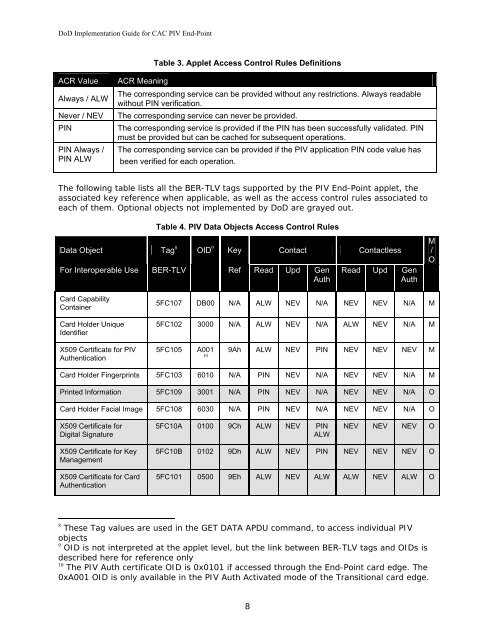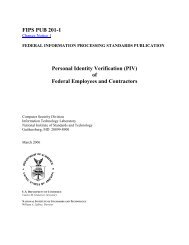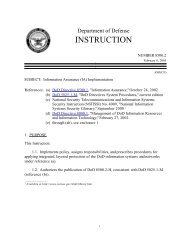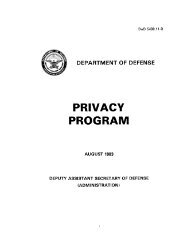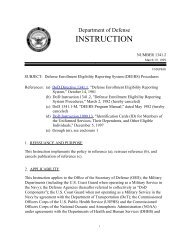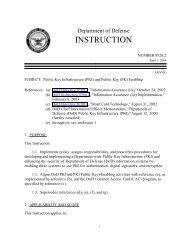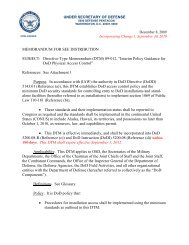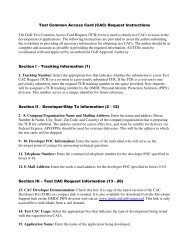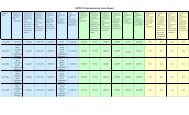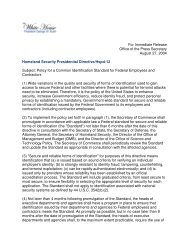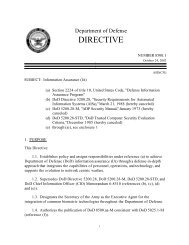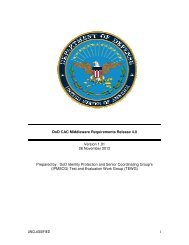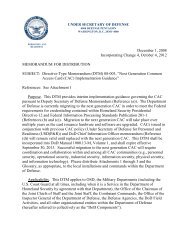DoD Implementation Guide for CAC PIV End-Point - Common ...
DoD Implementation Guide for CAC PIV End-Point - Common ...
DoD Implementation Guide for CAC PIV End-Point - Common ...
Create successful ePaper yourself
Turn your PDF publications into a flip-book with our unique Google optimized e-Paper software.
<strong>DoD</strong> <strong>Implementation</strong> <strong>Guide</strong> <strong>for</strong> <strong>CAC</strong> <strong>PIV</strong> <strong>End</strong>-<strong>Point</strong><br />
ACR Value ACR Meaning<br />
Table 3. Applet Access Control Rules Definitions<br />
Always / ALW<br />
The corresponding service can be provided without any restrictions. Always readable<br />
without PIN verification.<br />
Never / NEV The corresponding service can never be provided.<br />
PIN The corresponding service is provided if the PIN has been successfully validated. PIN<br />
must be provided but can be cached <strong>for</strong> subsequent operations.<br />
PIN Always /<br />
PIN ALW<br />
The corresponding service can be provided if the <strong>PIV</strong> application PIN code value has<br />
been verified <strong>for</strong> each operation.<br />
The following table lists all the BER-TLV tags supported by the <strong>PIV</strong> <strong>End</strong>-<strong>Point</strong> applet, the<br />
associated key reference when applicable, as well as the access control rules associated to<br />
each of them. Optional objects not implemented by <strong>DoD</strong> are grayed out.<br />
Table 4. <strong>PIV</strong> Data Objects Access Control Rules<br />
Data Object Tag 8 OID 9 Key Contact Contactless<br />
For Interoperable Use BER-TLV<br />
Card Capability<br />
Container<br />
Card Holder Unique<br />
Identifier<br />
X509 Certificate <strong>for</strong> <strong>PIV</strong><br />
Authentication<br />
Ref Read Upd Gen<br />
Auth<br />
8<br />
Read Upd Gen<br />
Auth<br />
5FC107 DB00 N/A ALW NEV N/A NEV NEV N/A M<br />
5FC102 3000 N/A ALW NEV N/A ALW NEV N/A M<br />
5FC105 A001<br />
10<br />
9Ah ALW NEV PIN NEV NEV NEV M<br />
Card Holder Fingerprints 5FC103 6010 N/A PIN NEV N/A NEV NEV N/A M<br />
Printed In<strong>for</strong>mation 5FC109 3001 N/A PIN NEV N/A NEV NEV N/A O<br />
Card Holder Facial Image 5FC108 6030 N/A PIN NEV N/A NEV NEV N/A O<br />
X509 Certificate <strong>for</strong><br />
Digital Signature<br />
X509 Certificate <strong>for</strong> Key<br />
Management<br />
X509 Certificate <strong>for</strong> Card<br />
Authentication<br />
5FC10A 0100 9Ch ALW NEV PIN<br />
ALW<br />
M<br />
/<br />
O<br />
NEV NEV NEV O<br />
5FC10B 0102 9Dh ALW NEV PIN NEV NEV NEV O<br />
5FC101 0500 9Eh ALW NEV ALW ALW NEV ALW O<br />
8<br />
These Tag values are used in the GET DATA APDU command, to access individual <strong>PIV</strong><br />
objects<br />
9<br />
OID is not interpreted at the applet level, but the link between BER-TLV tags and OIDs is<br />
described here <strong>for</strong> reference only<br />
10<br />
The <strong>PIV</strong> Auth certificate OID is 0x0101 if accessed through the <strong>End</strong>-<strong>Point</strong> card edge. The<br />
0xA001 OID is only available in the <strong>PIV</strong> Auth Activated mode of the Transitional card edge.


